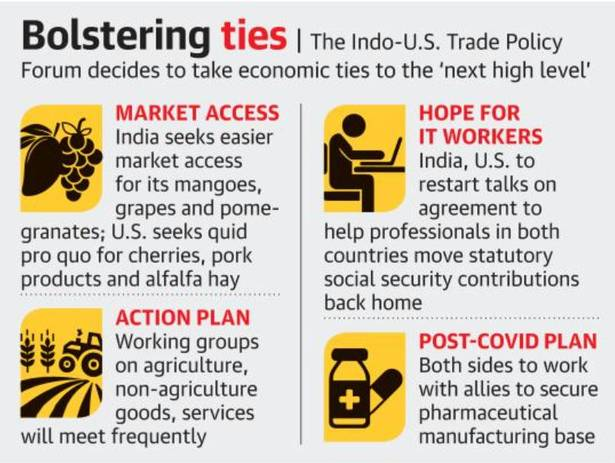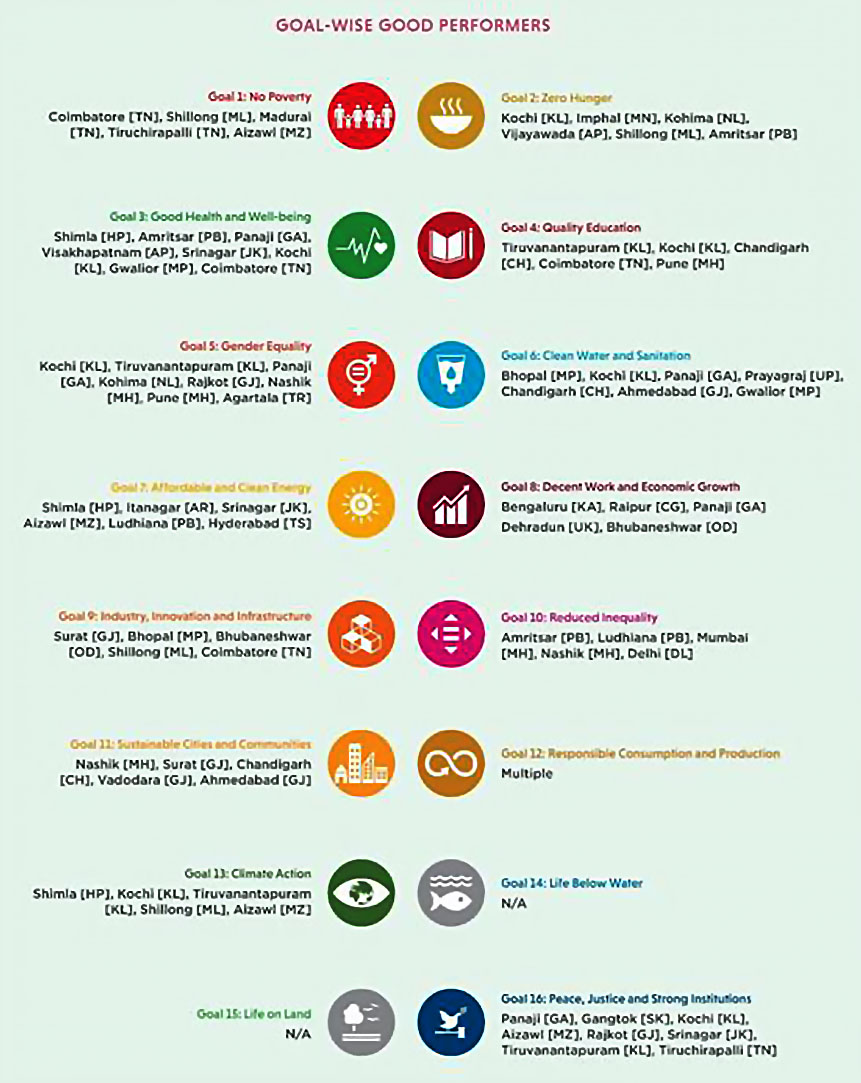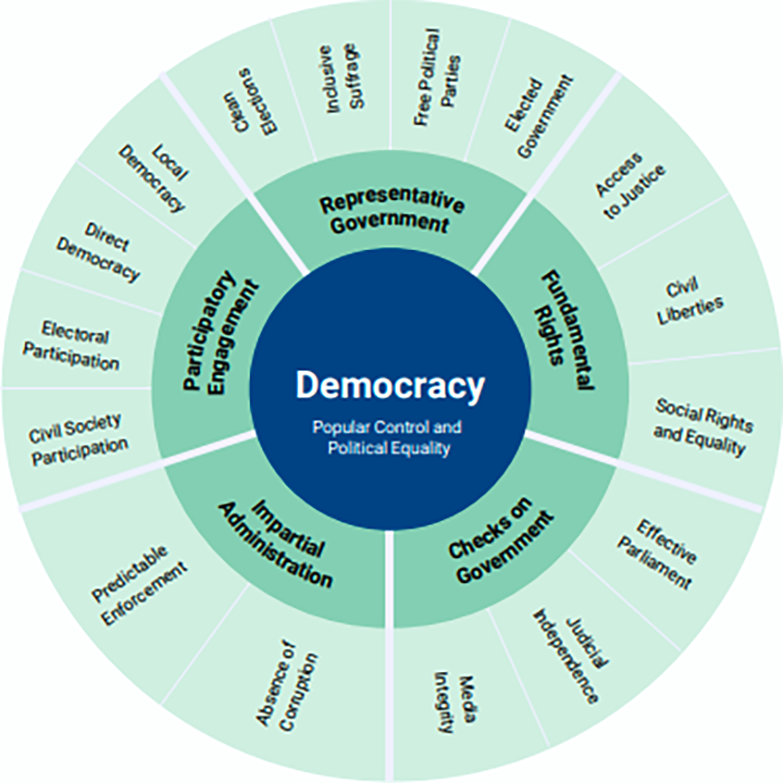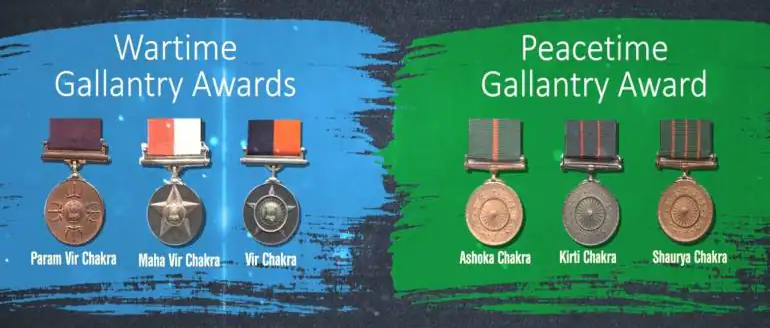International Relations
India-US Trade Policy Forum
Why in News
Recently, after a gap of four years, the Trade Policy Forum (TPF) was convened between the United States and India. The Forum resolved to take economic ties between the two countries to the ‘next high level’ and exchanged views on ‘potential targeted tariff reductions’.
Key Points
- Aim: To activate working groups of the TPF on agriculture, non-agriculture goods, services, investment, and intellectual property to meet frequently and address issues of mutual concern in a mutually beneficial manner.
- The idea is to deliver tangible benefits to both countries by resolving outstanding market access issues.
- Highlights of the forum:
- Mutual Market Access: The Forum has decided to forge an agreement to facilitate U.S. market access from India, and reciprocate with similar access in the Indian market to many agriculture and animal products.
- Restoration of the GSP: India has sought restoration of the GSP (Generalized System of Preferences) benefits by the U.S.
- Totalisation Agreement: The Forum also agreed on the significance of negotiating a Social Security Totalization Agreement in the interest of workers from both sides.
- A Totalization Agreement is a convention between two countries preventing duplicate social security contributions for the same income.
- It would allow workers from both countries to move their retirement savings, the lack of which particularly affects Indian IT workers in the U.S.
- Towards Rules-based Global Trading System: India and the U.S. also discussed engagement in various multilateral trade bodies including the World Trade Organisation (WTO) and the G20 for achieving a shared vision of a transparent, rules-based global trading system among market economies and democracies.
- The Forum also decided to find mutually agreed solutions on outstanding WTO disputes between the two countries.
- Ethanol Supply: The U.S. indicated an interest in supplying ethanol to India for its goal of 20% ethanol blending with petrol by 2025.
- Pharma Cooperation: The two sides decided to partner with allies in developing a secure pharmaceutical manufacturing base and de-risk global supply chains in such critical sectors like health.
- Services Front: The Forum discussed ways in which legal, nursing and accountancy services can facilitate growth in trade and investment, and sought to work together on electronic payment services and the digital economy.
- Collaboration in Critical Technologies: Both countries recognise the importance of critical and emerging technologies like cyberspace, semiconductors, Artificial Intelligence, 5G, and future generation telecommunications technology.
- Climate Change: Both countries exchanged views on approaches to increase the utilization of renewable energy to achieve net-zero emissions, as agreed in the India – US Climate and Clean Energy Agenda 2030 Partnership.
Way Forward
- Initiating Tariff Removal: The first step towards a potential deal is for India to take the initiative and consider unilaterally removing its retaliatory tariffs. This will represent India as willing to be a constructive player in trade talks.
- Even though removing the tariffs without a commitment from the US is a leap of faith, it ultimately will be beneficial for the bilateral trade relationship.
- Together Countering China: From a strategic point of view, one of the ways that India can counter China is through deepening trade ties with partners who are committed to supporting India’s growth.
- A deal with the US will be beneficial for India, both strategically and economically.
- As the US companies assess whether to shift some of their manufacturing from China, a vibrant trade strategy can complement the Production-Linked Incentive (PLI) schemes, and help to boost both manufacturing and exports.
- Facilitating Digital Growth: To promote further growth in the digital sphere, which represents over USD 100 billion of bilateral trade, the two must address several foundational issues; digital service tax, cross-border data flows and common cellular standards.
- It’s important that on the digital services tax, India accords with emerging global agreements that will accelerate trade.
Source: TH
Governance
SDG Urban Index: NITI Aayog
Why in News
Recently, NITI Aayog under the Indo-German Cooperation released the inaugural Sustainable Development Goals (SDGs) Urban Index and Dashboard 2021–22.
- Earlier in June 2021, the third edition of the Sustainable Development Goals (SDG) India Index and Dashboard 2020–21 was released by NITI Aayog.
Key Points
- About:
- The index and dashboard are a result of the NITI Aayog-Germany's International Cooperation Agency (GIZ) and BMZ collaboration focused on driving SDG localization in our cities, under the umbrella of Indo-German Development Cooperation.
- It ranks 56 urban areas on 77 SDG indicators across 46 targets of the SDG framework.
- It will further strengthen SDG localization and institute robust SDG monitoring at the city level.
- Ranking Scale:
- The urban areas are ranked on a scale of 0-100.
- A score of 100 implies that the urban area has achieved the targets set for 2030; a score of 0 implies that it is the farthest from achieving the targets among the selected urban areas.
- Overall or composite urban area scores are then generated from the Goal-wise scores to measure aggregate performance of the urban area.
- Urban areas have been classified as below based on their composite score:
- Aspirant: 0–49
- Performer: 50–64
- Front-Runner: 65–99
- Achiever: 100
- Performance of the States:
- Top Performers:
- Shimla, Coimbatore, Chandigarh, Thiruvananthapuram and Kochi.
- Worst Performers:
- Dhanbad, Meerut, Itanagar, Guwahati and Patna.
- Top Performers:
- Significance Of the Index:
- Cities are fast becoming engines of growth. The SDG Urban index and dashboard will go a long way in instituting a robust SDG monitoring system in our cities, and is a milestone step in our SDG localisation journey.
- The Niti Aayog is of the view that this transformative change is quite essential, given the increasing prominence of our cities and urban areas in charting the future of development in India.
- It highlights the strengths and gaps of Urban Local Body (ULB) level data, monitoring, and reporting systems.
- Cities are fast becoming engines of growth. The SDG Urban index and dashboard will go a long way in instituting a robust SDG monitoring system in our cities, and is a milestone step in our SDG localisation journey.
Indo-German Development Cooperation
- Background:
- The year 2008 marked 50 years of Indo-German development cooperation. Begun in the 1950s, development cooperation with India grew so rapidly that in a short time it became the largest recipient of German development assistance.
- The construction of the Rourkela Steel Plant in Orissa was a hallmark of this intensive cooperation in the early 1960s.
- Later, both countries set up one of India's premiere educational institutions - the Indian Institute of Technology in Madras.
- In the 1990’s, development cooperation dealt with the issues of poverty reduction and social infrastructure.
- About:
- Indo-German development cooperation is a solid pillar of the Indo-German strategic partnership.
- Both countries are equally committed to achieving the Millennium Development Goals (MDGs); further, they want to tackle global challenges in the fields of climate and environment.
- It is well integrated in the foreign policy framework of relations between India and Germany.
- India is viewed by Germany as one of the Global Development Partners that have a key role to play in solving global development issues.
- Programme Focus:
- Today, the Indo-German development cooperation programme focuses on the following mutually agreed priority areas:
- Energy
- Environment and Management of Natural Resources
- Sustainable Urban Development
- Today, the Indo-German development cooperation programme focuses on the following mutually agreed priority areas:
Source: PIB


Governance
PESA Act
Why in News
Recently, the Chhattisgarh government has formulated draft rules under Panchayat Extension to Scheduled Areas (PESA) Act, 1996, terming it the Chhattisgarh Panchayat Provisions (Extension of the Scheduled) Rules, 2021.
- Tribals in Chhattisgarh have been demanding the enactment of PESA rules for some time, as it would give them more power over their resources.
- The bill envisages instituting devaluation of power, and strengthening the gram sabhas at the village level.
- Six states (Himachal Pradesh, Andhra Pradesh, Telangana, Rajasthan, Gujarat, Maharashtra) have formed the PESA laws, and Chhattisgarh would become the seventh state if the rules are enacted.
Key Points
- About PESA Act 1996:
- Background: To promote local self-governance in rural India, the 73rd constitutional amendment was made in 1992.
- Through this amendment, a three-tier Panchayati Raj Institution was made into a law.
- However, its application to the scheduled and tribal areas under Article 243(M) was restricted.
- After the Bhuria Committee recommendations in 1995, PESA Act 1996 came into existence for ensuring tribal self-rule for people living in scheduled areas of India.
- Role of State Government: PESA, was enacted by the Centre to ensure self-governance through gram sabhas (village assemblies) for people living in scheduled areas.
- State governments were required to amend their respective Panchayat Raj Acts without making any law that would be inconsistent with the mandate of PESA.
- Objective: It legally recognises the right of tribal communities, residents of the scheduled areas, to govern themselves through their own systems of self-government.
- It acknowledges their traditional rights over natural resources.
- Background: To promote local self-governance in rural India, the 73rd constitutional amendment was made in 1992.
- Importance of Gram Sabha in PESA Act:
- Democratic Decentralisation: PESA empowers gram sabhas to play a key role in approving development plans and controlling all social sectors. This includes management of :
- Resources over jal, jangal, zameen (water, forest and land)
- Minor forest produce
- Human resources: Processes and personnel who implement policies
- Managing local markets
- Preventing land alienation
- Regulating intoxicants among other things
- Preserving Identity: The powers of gram sabhas include maintenance of cultural identity and tradition, control over schemes affecting the tribals, and control over natural resources within the area of a village.
- Conflict Resolution: The PESA Act thus enables gram sabhas to maintain a safety net over their rights and surroundings against external or internal conflicts.
- Public Watchdog: The gram sabha would have the powers to monitor and prohibit the manufacturing, transport, sale and consumption of intoxicants within their village limits.
- Democratic Decentralisation: PESA empowers gram sabhas to play a key role in approving development plans and controlling all social sectors. This includes management of :
- Issues Related to PESA:
- Partial Implementation: The state governments are supposed to enact state laws for their Scheduled Areas in consonance with this national law.
- This has resulted in the partially implemented PESA.
- The partial implementation has worsened self-governance in Adivasi areas,like in Jharkhand.
- Administrative Hurdles: Many experts have asserted that PESA did not deliver due to the lack of clarity, legal infirmity, bureaucratic apathy, absence of a political will, resistance to change in the hierarchy of power, and so on.
- Followed in Letter Rather than Spirit: Social audits conducted across the state have also pointed out that in reality different developmental schemes were being approved on paper by Gram Sabha, without actually having any meeting for discussion and decision making.
- Partial Implementation: The state governments are supposed to enact state laws for their Scheduled Areas in consonance with this national law.
India’s Tribal Policy
- In India, most of the tribes are collectively identified under Article 342 (1&2) as "Scheduled Tribes".
- Their right to self-determination is guaranteed by Part X: The Scheduled and Tribal Areas – Article 244: Administration of Scheduled Areas and Tribal Areas.
- That is, Fifth and Sixth Schedules of the Indian Constitution.
- The Provisions of the Panchayats (Extension to Scheduled Areas) Act, 1996 or PESA.
- The Tribal Panchsheel Policy
- Scheduled Tribes and Other Traditional Forest Dwellers (Recognition of Forest Rights) Act, 2006 concerns the rights of forest-dwelling communities to land and other resources.
Way Forward
- PESA, if it is implemented in letter and spirit, will rejuvenate the dying self-governance system in the tribal area.
- This will also give an opportunity to correct the loopholes in the traditional governance system and make it a more gender-inclusive and democratic space.
Source: IE


Governance
Global State of Democracy Report 2021
Why in News
According to the recently released Global State of Democracy Report, 2021, the number of countries moving towards authoritarianism in 2020 was higher than that of countries becoming more democratic.
Key Points
- About:
- The report aims to influence the global debate and analyses current trends and challenges to democracy, exacerbated by the Covid-19 pandemic.
- It offers specific policy recommendations to spark new and innovative thinking for policymakers, governments and civil society organizations supporting democracy.
- It is released by the International Institute for Democracy and Electoral Assistance (International-IDEA).
- About International Institute for Democracy and Electoral Assistance:
- International IDEA is an intergovernmental organization that supports sustainable democracy worldwide.
- It was founded in 1995 and currently has 33 member states.
- International IDEA advances democracy worldwide, as a universal human aspiration and an enabler of sustainable development, through support to the building, strengthening and safeguarding of democratic political institutions and processes at all levels.
- Highlights of the Report:
- Democratic Decline: Democratically elected Governments, including established democracies, are increasingly adopting authoritarian tactics.
- Effect of Pandemic: The pandemic placed considerable stress on democracy across the region by imposing inevitable restrictions on movement and—where governments were sensitive to criticism —also restrictions on freedom of expression.
- The year 2020 was the worst on record, in terms of the number of countries affected by deepening autocratisation.
- The pandemic has thus had a particularly damaging effect on non-democratic countries, further closing their already reduced civic space.
- Popular Support: This democratic backsliding has often enjoyed significant popular support.
- Indian Scenario: The report highlighted the case of Brazil and India as “some of the most worrying examples of backsliding.
- However, India remained in the category of a mid-level performing democracy as it has since 2000.
- Major Suggestions:
- New Social Contract: There is a need to deliver on political or civic reforms or develop a new social contract that closes the gap between what people want and what governments currently deliver.
- This can be done by designing responsive, inclusive, accountable, and transparent institutions oriented towards achieving sustainable development.
- Strengthening Institutions: Rebuilding existing institutions by updating practices in established democracies, building democratic capacity in new democracies, and protecting electoral integrity, fundamental freedoms and rights, and the checks and balances essential to thriving democratic systems.
- Strengthening Civil Society: Preventing the rising authoritarianism and democratic backsliding can be done by investing in education and by supporting independent civil society, combatting disinformation and supporting free and independent media that facilitates the growth of democratic cultures, values and practice.
- New Social Contract: There is a need to deliver on political or civic reforms or develop a new social contract that closes the gap between what people want and what governments currently deliver.
Source: TH


Science & Technology
Fastest Spinning White Dwarf: J0240+1952
Why in News
Recently, a team of astronomers has confirmed the fastest spinning white dwarf (named J0240+1952) that completes a full rotation once every 25 seconds.
Key Points
- About:

- It is part of a binary star system; under the influence of the magnetic propeller system, its immense gravity is pulling material from its larger companion star in the form of plasma.
- Under the magnetic propeller system, the white dwarf attracts plasma from the binary star system. However, the magnetic field of white dwarf acts as a protective barrier, causing most of the falling plasma to be propelled away from the white dwarf.
- White Dwarf:
- White dwarfs are stars that have burned up all of the hydrogen they once used as nuclear fuel.
- Such stars have very high density.
- A typical white dwarf is half the size of our Sun and has a surface gravity 100,000 times that of Earth.
- Stars like our sun fuse hydrogen in their cores into helium through nuclear fusion reactions.
- Fusion in a star's core produces heat and outward pressure (they bloat up as enormous red giants), but this pressure is kept in balance by the inward push of gravity generated by a star's mass.
- When the hydrogen, used as fuel, vanishes and fusion slows, gravity causes the star to collapse in on itself into white dwarfs.
- Black Dwarf: Eventually—over tens or even hundreds of billions of years—a white dwarf cools until it becomes a black dwarf, which emits no energy. Because the universe's oldest stars are only 10 billion to 20 billion years old there are no known black dwarfs
- It must be noted that not all white dwarfs cool and transform into black dwarfs.
- Those white dwarfs which have enough mass reach a level called the Chandrasekhar Limit.
- At this point the pressure at its center becomes so great that the star will detonate in a thermonuclear supernova.
- White dwarfs are stars that have burned up all of the hydrogen they once used as nuclear fuel.
Chandrasekhar Limit
- Chandrasekhar Limit is the maximum mass theoretically possible for a stable white dwarf star.
- A limit which mandates that no white dwarf (a collapsed, degenerate star) can be more massive than about 1.4 times the mass of the Sun.
- Any degenerate object more massive must inevitably collapse into a neutron star or black hole.
- The limit is named after the Nobel laureate Subrahmanyan Chandrasekhar, who first proposed the idea in 1931.
- He was awarded the Nobel Prize in Physics in 1983 for his work on the physical processes involved in the structure and evolution of stars.
Source: IE
Important Facts For Prelims
Bharat Gaurav Scheme
Why in News
Recently, the Indian Railways has announced the new scheme ‘Bharat Gaurav’ to tap the huge potential of tourism.
Key Points
- About:
- Under the scheme, now trains have a third segment for tourism. Till now, the Railways had passenger segments and goods segments.
- These trains are not regular trains that will run as per a timetable but will be more on the lines of the Ramayana Express being run by the IRCTC.
- It was announced under the theme-based tourist circuit trains. These trains will be run, by both private players and IRCTC, in theme-based circuits
- By theme-based tourism (circuits), the railways means trains like Guru Kripa that goes to all places related to Guru Nanak or a Ramayan-themed train to touch upon places related to Lord Ram.
- Anyone, from societies, trusts, consortia and even state governments can apply to take these trains and run them on special tourism circuits based on a theme.
- Service Provider will offer all inclusive packages to tourists including rail travel, hotel accommodation, sightseeing arrangement, visit to historical/heritage sites, tour guides etc.
- Under the scheme, now trains have a third segment for tourism. Till now, the Railways had passenger segments and goods segments.
- Benefits of such Scheme:
- These trains will help realise India’s rich cultural heritage and magnificent historical places to the people of India and the world. They will also help in tapping the vast tourism potential of India.
- Other Related Scheme:
- Swadesh Darshan Scheme
- PRASHAD Scheme
- Buddhist Conclave
- Dekho Apna Desh’ Initiative
Tourism in India
- Tourism in India is important for the country's economy and is growing rapidly.
- According to the World Travel and Tourism Council, the travel & tourism industry’s contribution to the Gross Domestic Product (GDP) was USD 121.9 billion in 2020 and this is expected to reach USD 512 billion by 2028.
- In India, the industry’s direct contribution to the GDP is expected to record an annual growth rate of 10.35% between 2019 and 2028.
- Also, the Travel and Tourism Competitiveness Report 2019 ranked India 34th out of 140 countries overall, showing India’s efforts to improve in the field.
Source: PIB


Important Facts For Prelims
Gallantry Awards
Why in News
Recently, group Captain Abhinandan Varthaman was awarded Vir Chakra which is a wartime gallantry award, by the President of India.
- The gallantry awards are announced twice in a year — first on the occasion of the Republic Day and then on the occasion of the Independence Day.
Key Points
- Gallantry Awards in India (History):
- Post-Independence, first three gallantry awards namely Param Vir Chakra, Maha Vir Chakra and Vir Chakra were instituted by the government of India on January 26th 1950 which were deemed to have effect from August 15th,1947.
- Thereafter, other three gallantry awards — the Ashoka Chakra Class-I, the Ashoka Chakra Class-II and the Ashoka Chakra Class-III — were instituted in 1952, which were deemed to have effect from August 15, 1947.
- These awards were renamed as Ashoka Chakra, Kirti Chakra and Shaurya Chakra respectively in January 1967.
- People Eligible for the Awards:
- All officers of all ranks of the Army, Navy and the Air Force or of any of the reserve forces, territorial army and any other lawfully constituted armed forces.
- In addition to the above-mentioned personnel, matrons, sisters, nurses, alongside the staff of the nursing services and other services pertaining to hospitals and nursing and civilians, both male and females, serving regularly or temporarily under the orders, directions or supervision of any of the above-mentioned forces.
- Wartime Highest Gallantry Awards:
- Param Vir Chakra:
- It is India’s highest military decoration awarded for displaying distinguished acts of valour during wartime whether on land, at sea or in the air.
- Maha Vir Chakra:
- It is the second highest gallantry award for acts of conspicuous gallantry in the presence of the enemy whether on land, at sea or in the air.
- Vir Chakra:
- It is the country's third-highest wartime gallantry award after Param Vir Chakra and Maha Vir Chakra.
- Param Vir Chakra:
- Peacetime Highest Gallantry Awards:
- Ashoka Chakra:
- It is the highest military award during peacetime for valour, courageous action or sacrifice.
- It is awarded for most conspicuous bravery or some act of daring or pre-eminent act of valour or self-sacrifice otherwise than in the face of the enemy.
- Kirti Chakra:
- It is the second highest peacetime gallantry award and is awarded for valour, courageous action or self-sacrifice away from the field of battle.
- Shaurya Chakra:
- It is awarded to the personnel of the armed forces for instances of extraordinary gallantry.
- Ashoka Chakra:
- Other Awards:
- Sena Medal:
- It is awarded for acts of exceptional devotion to duty or courage in the Army.
- Nao Sena Medal:
- It is awarded for individual acts of exceptional devotion to duty or courage in the Navy.
- Vayu Sena Medal:
- It is awarded for individual acts of exceptional devotion to duty or courage in the Air Force.
- Sena Medal:
Source: TH









